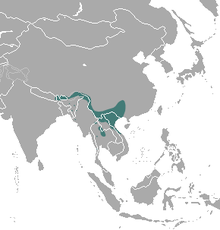- Back-striped weasel
-
Back-striped Weasel 
An 19th century representation of Mustela strigidorsa Conservation status Scientific classification Kingdom: Animalia Phylum: Chordata Class: Mammalia Order: Carnivora Family: Mustelidae Genus: Mustela Species: M. strigidorsa Binomial name Mustela strigidorsa
Gray, 1853
Back-striped Weasel range The Back-striped Weasel (Mustela strigidorsa)[2] is one of the most enigmatic mammals in the north-east Oriental region, even though it occurs from Nepal east through north east India, Myanmar and southern China to Vietnam, and south to central Laos at altitudes from 1000m to 2500m.[2][3][4][5]
It is distinguished from all other species of Mustela by the presence of a narrow silvery dorsal streak extending from the occiput almost to the root of the tail, and of a corresponding yellowish ventral streak from the chest along the abdomen.
The general body colour of the dorsal surface varies from deep to paler chocolate brown, sometimes a little paler on the head and usually slightly darkened along the side of the dorsal streak. The tail and limbs are similar in shade as dorsal body surface. The upper lip from rhinarium, the chin and the throat up to the level of the ears are pale varying from whitish to ochre. On the hind throat and fore chest the pale hue gradually narrows in extent and is quite narrow between the fore legs, where it passes into the ventral streak, which expands on the inguinal region between thighs.
The soles of the feet are naked. The tail is small in size being almost between one third to one half the length of the head and body, and bushy. The length of head and body of a female from Laos was around 285 mm while the tail length was 152 mm.
Very little is known about its behaviour and biology. So far only eight animals of this species have been examined scientifically: three from Sikkim, and one each from Nepal, Laos, Myanmar, Tanintharyi and Thailand.[6] Any recent sighting may have gone unreported. In Naga hills it was seen stalking a large bandicoot.[5][citation needed] The specimen from Myanmar came from dense hill jungle.[5]
References
- ^ Duckworth, J.W., Yonzon, P., Abramov, A. & Timmons, R.J. (2008). Mustela strigidorsa. In: IUCN 2008. IUCN Red List of Threatened Species. Downloaded on 21 March 2009. Database entry includes a brief justification of why this species is of least concern
- ^ a b Grubb, Peter (16 November 2005). Wilson, Don E., and Reeder, DeeAnn M., eds. ed. Mammal Species of the World (3rd ed.). Baltimore: Johns Hopkins University Press, 2 vols. (2142 pp.). ISBN 978-0-8018-8221-0. OCLC 62265494. http://www.bucknell.edu/msw3/browse.asp?id=14001480.
- ^ Choudhury, A. U. 1997a. Checklist of the mammals of Assam. Revised 2nd edn. Gibbon Books & ASTEC, Guwahati
- ^ Datta, Aprajita. (1999). SMALL CARNIVORES IN TWO PROTECTED AREAS OF ARUNACHAL PRADESH. Journal of Bombay Natural History Society. 96: 399-404
- ^ a b c Pocock, R. I., 1941. The Fauna of British India, including Ceylon and Burma. Mammalia Vol. II. Carnivora (suborders Aeluroidae (part) and Arctoidae). Taylor & Francis, Ltd., London, United Kingdom. 503 pp
- ^ KRUSKA, D. (1990): Mustelids. In: Grzimek's Encyclopedia of Mammals. Vol. 3. Ed. by S. P. Parker. MacGraw-Hill, New York. Pp. 388 – 447
Categories:- IUCN Red List least concern species
- Weasels
- Mammals of Southeast Asia
- Mammals of South Asia
Wikimedia Foundation. 2010.

